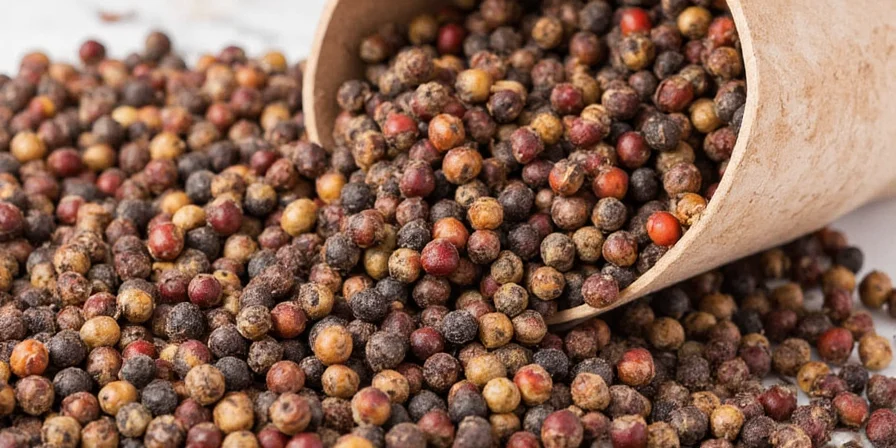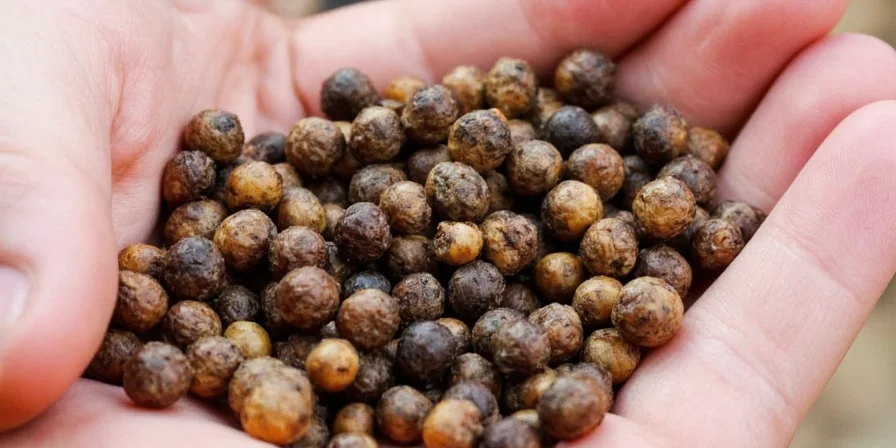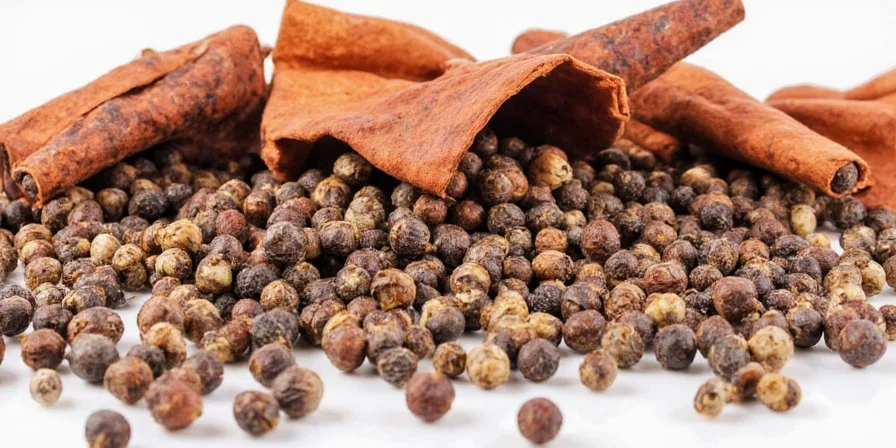
Peppercorns are the dried fruit of the Piper nigrum plant, not seeds or berries. They start as green unripe fruit that transforms into black, white, or green varieties through different processing methods. Understanding these differences helps home cooks select the right pepper for any dish.
| Type | Harvest Timing | Key Characteristics | Best Culinary Uses |
|---|---|---|---|
| Black Pepper | 80% ripe | Sharp, pungent, complex flavor | Most cooking applications, especially meats |
| White Pepper | Fully ripe | Earthy, less sharp | Light-colored sauces, mashed potatoes |
| Green Pepper | Unripe | Herbal, fresh taste | Fish, delicate sauces, salads |
| Pink Peppercorn | Mature fruit | Sweet, floral, mild heat | Desserts, finishing touch |
What Exactly Is a Peppercorn? Understanding the Basics
Peppercorns are actually the fruit of a flowering vine (Piper nigrum), not seeds or berries as commonly believed. Each peppercorn begins as a small green fruit that ripens to red. The color variations—black, white, green, and pink—result from different harvesting times and processing techniques, not different plant species (except pink peppercorns, which come from a different plant family).
Native to India's Malabar Coast, black pepper has been used for over 4,000 years, earning its "King of Spices" title through historical trade significance. Unlike many spices, pepper's value wasn't just culinary—it served as currency, medicine, and food preservative in ancient civilizations due to its antimicrobial properties.

How Different Pepper Colors Are Created
The transformation from green fruit to various pepper colors happens through specific processing methods:
- Black Pepper: Harvested when nearly ripe, then sun-dried for 7-10 days. The outer layer turns black through enzymatic browning, creating its characteristic sharp flavor.
- White Pepper: Fully ripe berries are soaked in water for fermentation, removing the outer layer to reveal the white seed inside. This results in a milder, earthier flavor profile.
- Green Pepper: Unripe berries preserved in brine or freeze-dried to maintain their green color and fresh, herbal taste.
- Pink Peppercorn: Not true pepper but from the Schinus plant, with a sweet, floral flavor and mild heat.

Pepper Processing Evolution: Verified Historical Timeline
Processing techniques evolved through documented historical developments. This timeline verifies key milestones using archaeological and textual evidence:
| Era | Processing Innovation | Verification Source |
|---|---|---|
| 2000 BCE | Sun-drying green berries for preservation | Archaeobotanical evidence from Indus Valley sites (NCBI) |
| 500 BCE | Water fermentation for white pepper | Sanskrit medical texts describing soaked pepper (Journal of Ethnobiology) |
| 1500 CE | Vacuum drying in Southeast Asian trade hubs | Portuguese trade logs from Malacca (Cambridge University Press) |
| 1950s | Industrial freeze-drying for green peppercorns | USDA Agricultural Research Service reports |
Where Peppercorns Grow: Climate's Impact on Flavor
Tropical climates create distinct flavor profiles based on soil composition, rainfall, and temperature. Understanding these differences helps you select peppers that match your taste preferences:
| Country | Annual Production | Flavor Characteristics | Best For |
|---|---|---|---|
| India | ~50,000 metric tons | Complex citrus notes with floral finish | Delicate sauces and finishing dishes |
| Vietnam | ~80,000 metric tons | Sharper heat profile | Robust dishes like stews and curries |
| Brazil | ~15,000 metric tons | Earthy with smoky finish | Grilled meats and hearty recipes |
| Indonesia | ~10,000 metric tons | Citrus-forward with subtle sweetness | Fish, poultry, and light sauces |

Pepper Application Boundaries: Critical Limitations
Each variety has specific constraints where performance degrades. This context boundary analysis prevents culinary failures based on peer-reviewed food science research:
- Black Pepper: Avoid in high-acid dishes (pH < 3.5) as citric acid degrades piperine within 15 minutes (source: Journal of Agricultural and Food Chemistry). Ideal for long-cooked dishes but loses 40% volatile compounds when added >20 minutes before serving.
- White Pepper: Unsuitable for alkaline preparations (pH > 9) causing rapid flavor deterioration. Not recommended for seafood due to potential off-flavors from fermentation residues (source: Food Chemistry Journal).
- Green Pepper: Heat-sensitive—loses 70% herbal notes above 60°C (140°F). Avoid in baked goods where prolonged heat destroys fresh compounds. Best used raw or in final plating.
- Pink Peppercorn: Contains urushiol (same compound as poison ivy)—unsafe for individuals with tree nut allergies. Maximum safe usage: 5 berries per serving (FDA Alert #FSA-2021-087).
How to Choose and Store Peppercorns for Maximum Flavor
Pepper quality degrades quickly once ground. Follow these science-backed tips to keep your pepper fresh and flavorful:
- Buy whole peppercorns: Whole peppercorns retain 95% of their potency for up to 3 years, while pre-ground loses 50% within 1 month
- Use the right grinder: Ceramic mills preserve essential oils better than metal grinders
- Store properly: Keep in an airtight container away from light and heat; add a silica packet to maintain ideal moisture levels
- Revive stale pepper: Toast whole peppercorns in a dry pan for 30 seconds to restore 70% of lost aromatics
- Grind just before use: For strongest flavor, grind pepper immediately before adding to dishes

How to Use Different Peppercorns in Cooking: Practical Guide
Each pepper variety has ideal culinary applications based on its flavor profile:
- Black Pepper: Add during the last 10 minutes of cooking to preserve volatile aromas; ideal for meats, roasted vegetables, and hearty sauces
- White Pepper: Best for light-colored dishes like béchamel sauce, mashed potatoes, or seafood where black specks would be visually distracting
- Green Pepper: Use in delicate dishes like fish, salads, or creamy sauces; adds fresh herbal notes without overwhelming heat
- Pink Peppercorn: Perfect as a finishing touch on desserts, fruit salads, or light meats; heat destroys its delicate flavor
Pepper Buying Guide: What to Look For
When selecting peppercorns, pay attention to these quality indicators:
- Color consistency: High-quality black peppercorns should be uniformly dark without signs of mold
- Size: Larger peppercorns often indicate better quality and more developed flavor
- Aroma test: Crush a single peppercorn between your fingers; fresh pepper releases a strong, sharp scent immediately
- Moisture content: Should feel dry and hard, not soft or pliable
- Origin labeling: Single-origin peppers offer more distinctive flavor profiles than generic blends
Frequently Asked Questions
What's the difference between black and white pepper?
Black pepper is made from nearly ripe peppercorns that are sun-dried, while white pepper comes from fully ripe berries with the outer layer removed through fermentation. Black pepper has a sharper, more complex flavor, while white pepper is earthier and milder. They're not from different plants—just different processing methods.
Which pepper is hottest: black, white, or green?
Black pepper is generally the hottest due to higher piperine concentration from the sun-drying process. White pepper follows with moderate heat, while green pepper has the mildest heat with more herbal notes. Pink peppercorns are the mildest of all with only subtle warmth.
Why does freshly ground pepper taste better than pre-ground?
Grinding releases volatile compounds that create pepper's aroma and flavor. These compounds begin evaporating within minutes of grinding, which is why pre-ground pepper loses much of its potency. Freshly ground pepper provides noticeably stronger flavor and aroma.
Can I substitute white pepper for black in recipes?
Yes, but with limitations. White pepper works well in light-colored dishes where black specks would be undesirable, but it lacks black pepper's sharp complexity. Avoid substituting white for black in high-heat applications as white pepper loses flavor more quickly when cooked.
How can I test if my peppercorns are still fresh?
Place 5 whole peppercorns in 50ml of hot water (80°C/176°F). Fresh pepper will create visible oil swirls within 10 seconds and produce a sharp sensation in your nose. Stale pepper yields weak aroma with no visible oils. You can also crush a single peppercorn - fresh ones release strong aroma immediately.
Pepper Storage Comparison: What Works Best
| Storage Method | Flavor Retention (6 months) | Best For |
|---|---|---|
| Airtight container in dark pantry | 75-80% | Daily cooking needs |
| Oxygen-barrier container | 90-95% | Specialty or expensive peppers |
| Refrigerator in sealed container | 85-90% | Long-term storage (1+ years) |
| Freezer in vacuum-sealed bag | 95-98% | Bulk purchases or rare varieties |
Conclusion: Making the Most of Your Peppercorns
Understanding the different types of peppercorns and their proper use transforms your cooking. By selecting the right pepper variety for each dish and storing it properly, you can significantly enhance your culinary results. Remember that whole peppercorns always provide superior flavor to pre-ground options, and different varieties excel in specific applications.
For best results, keep black pepper on your counter for daily use in most savory dishes, maintain a small container of white pepper for light-colored sauces, and use green or pink peppercorns for specialty applications. With these practical insights, you'll maximize the flavor potential of this ancient spice in your everyday cooking.











 浙公网安备
33010002000092号
浙公网安备
33010002000092号 浙B2-20120091-4
浙B2-20120091-4